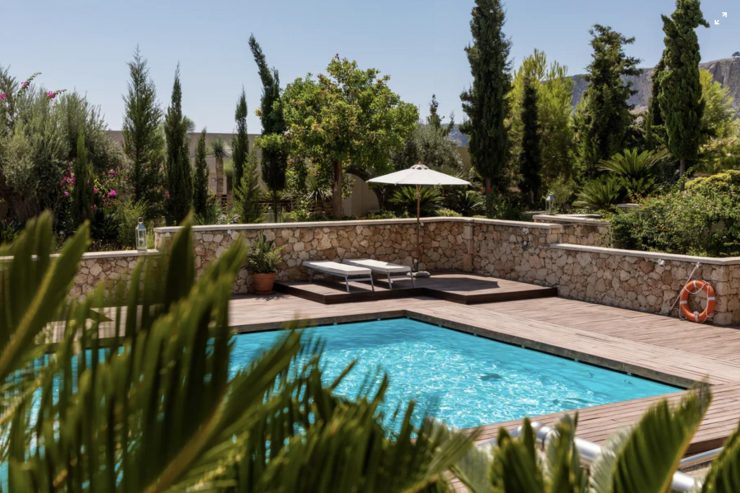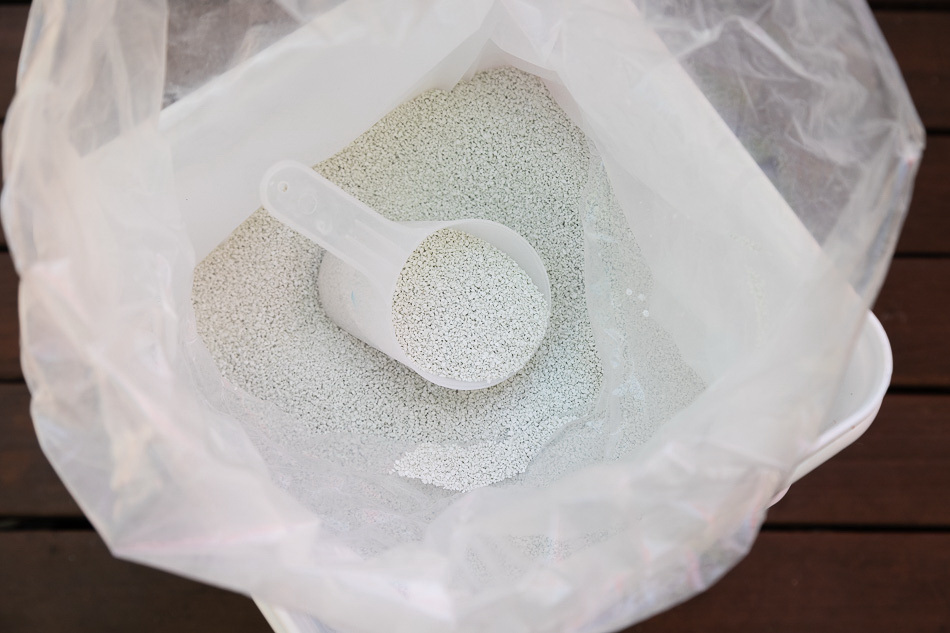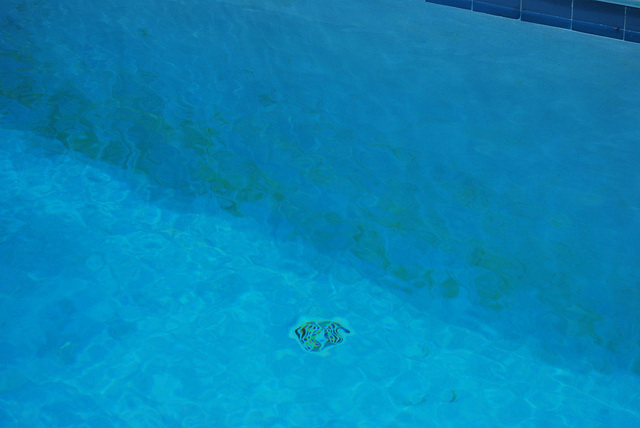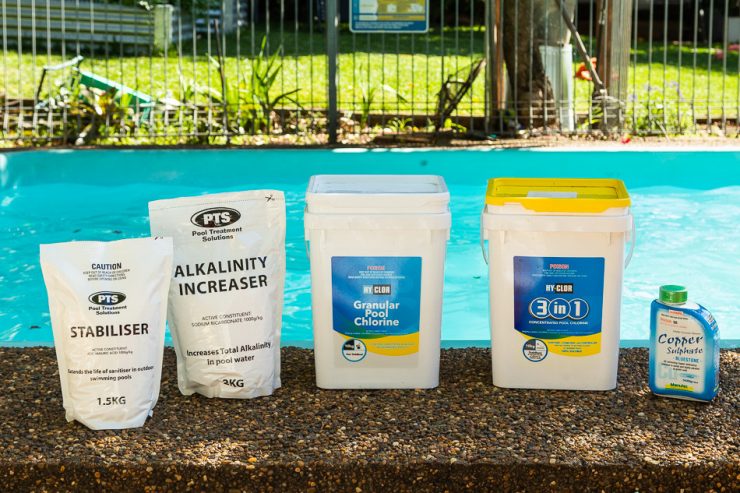If the pH is too high in your pool, you are only one of many dealing with this problem. This is why we’ve identified the top strategies on how to lower the pH in your pool just in time for the summer season ahead.
Of the many things you need to consider when preparing your swimming pool, the pH should be at the top of your list. Oftentimes overlooked, having the correct pH level is vital for maintaining the water in your pool.
There’s a lot of information out there that can lead you astray in finding the right answers. Let’s keep it simple here and dive into the options you can use to quickly reduce pH in your pool – just in time for you, your family, and your friends to enjoy!

Article Contents
What is pH in the Pool and Why is it Important?
pH is used to describe a scale of acidity or basicity of a solution. Ranging from 0-14, a pH of 7 is neutral, anything less than 7 represents an acidic or low pH solution, and anything more than 7 represents a basic or high pH (alkaline).
The pH, as well as alkalinity, is probably the most important value to stay on top of in your pool. It’s best to maintain a slightly neutral pH between 7.4-7.6 with an alkalinity level between 80-120 ppm.
Factors that cause pH to change in your pool:
- sanitizers (i.e. chlorine, bleach)
- evaporation
- pool chemicals
- alkalinity
- rain
- source water
- airborne debris
- swimmer wastes (sweat, sunscreen, makeup and I hate to say it, urine!)
When the pH shifts out of balance, it can wreak havoc on your pool’s chemistry and balance as it directly affects some of the chemical reactions that take place.
Does pH Effect Chlorine Effectiveness?
Chlorine is known by many as the number one chemical used for maintaining a swimming pool. It works its magic by disinfecting microorganisms.

For chlorine to do its job, it needs to be exposed to the right environment. Its ability to effectively kill bacteria depends on optimal pH and alkalinity levels.
A high pH can cause cloudy pool water; while a pool with low pH means the amount of available chlorine is lower. In both instances, an incorrect pH level will hinder chlorine’s effectiveness.
What Are the Effects of High pH in the Pool?
When your pool’s pH is too high, the basic (alkaline pH level) conditions can cause a variety of problems.
Problems for the Swimmers
Swimming in a pool with high pH causes irritation to your skin, eyes, and nasal passage. More on this later.
Problems for the Pool
High pH in a pool can cause the following problems:
- scale
- clogged filters
- reduction in chlorine effectiveness
- cloudy water
- algae
High pH pools can cause scaling to pipes which can impede water flow. Extra strain is put on your pump when water flow is impeded and not optimal.
A clogged up pool filter is also a side effect of a pool with high pH. A clogged up filter will again impede water circulation and could also shorten the life of your pump due to the pump needing to work harder.
And lastly, chlorine is less effective as a sanitizer at high pH levels, giving algae a chance to take hold. Chlorine works best with pool water that has a pH of 7.4-7.6.
Luckily, high pH can be lowered by adding an acid to your pool water.
What Causes High pH in the Pool?
As mentioned earlier, high pH is described as a pH test reading above 7.6. The pH can either rise naturally over time or go up with certain pool chemicals. It’s more common for a pool to have a low pH over a pool that has a high pH level.
Some of the main culprits of a high pH include:
1. High Alkalinity
When total alkalinity is too high, pH will usually be too high as well. That is, when alkalinity rises, pH normally rises too. These two factors fall hand in hand with one another whereby when one shifts, the other will follow close behind.
If you’re experiencing high pH and high alkalinity, lowering the alkalinity will also bring the pH down.
2. Algae

When you have algae in your pool, it uses up carbon dioxide. Due to some pesky science, the less carbon dioxide (CO2) that’s present in your pool, the higher the pH will become. Your pool will naturally become more alkaline over time as a result of the escaping CO2 gas particles.
Related Reading: Using Muriatic Acid To Clear A Green Pool Quickly
3. Pool Chemicals

Chemicals such as these can all raise pH:
- Some sanitizers
- Bicarb Soda / Baking Soda / Sodium Bicarbonate
- Soda Ash
Some sanitizers have a higher pH than others. For example, chlorine tablets generally have a low pH whilst calcium hypochlorite (Cal Hypo) has a higher pH (around 8). Overuse of high pH sanitizer will cause your pool’s pH levels to go up.
Salt water pools’ pH level can rise too as a side effect of this type of sanitizing system.
It seems obvious but overuse of chemicals used to raise pool pH can cause high pH in your pool too. The best advice when using any pool chemical is to add small amounts at a time, let it mix for a few hours then retest before adding more.
Can I Swim in a Pool with High pH?
Swimming in a pool with a high pH is a risky decision. The alkaline water will disrupt the chemical activity of chlorine, resulting in a poorly disinfected swimming pool. The presence of microorganisms, possible water diseases and germs such as cryptosporidiosis, E. coli, shigella and viruses can be harmful to your health.
In addition to potentially harmful water, swimming in water with high pH can irritate skin, eyes and your nasal passages.
It’s best to wait until the pH is back down to optimal values. This is the safest zone to be swimming in!
The Best Ways to Lower the pH in your Pool
If you’re experiencing a high pool pH, don’t sweat it because there are some simple solutions to get your pool back in balance. You can counteract a high pH by adding a pool acid to shift the pH back down towards neutral.
How to Lower Pool pH
There are a couple of different chemicals you can use to lower pool pH:
- Muriatic acid (aka Hydrochloric Acid)
- pH Decreaser (aka Sodium Bisulfate)
Adding either muriatic acid, hydrochloric acid or pH Decreaser (sodium bisulfate) will decrease BOTH the pH and alkalinity. You can get a pH decreaser here:
- Reduces pH to protect equipment and surfaces
- Optimizes sanitizer efficiency & helps prevent algae
- For pools and spas
How to Use Muriatic Acid to Lower Pool pH
As a strong acid, this chemical is a very effective way to lower the pH of your pool and lower total alkalinity. Muriatic acid can also be used to clean the pool surface but be careful, it’s a very powerful chemical.
How to Use Muriatic Acid:
1. Test your pool’s alkalinity and pH (liquid test kits are the best way to do this). You can get a good test kit here:
- Tests total alkalinity, free/combined chlorine, cyanuric acid, calcium hardness & pH
- Extremely accurate (better than test strips)
- For pools & spas
2. Measure the required acid and dilute in a large bucket of water in a 10:1 ratio. This will avoid any backsplash of pouring it directly into the pool.
3. Pour the solution into the deep end of the pool near the jets. Make sure the pump is circulating the water.
4. Wait at least 5 hours, preferably overnight before retesting your pool’s alkalinity & pH to determine if more acid is required. Repeat steps 2-4 as necessary.
5. Once you achieve normal alkalinity (80-120 ppm), check the pH again. If pH drops too low, you can simply aerate the pool or use pH increaser to get it back to optimal ranges.
**Use acid with extreme caution as this product can burn your skin. It will also stain decks and the pool surrounds if it splashes on them.**
How much Muriatic Acid to Lower Pool pH?
The amount of muriatic acid needed to decrease pool pH will depend on your pool’s water volume, pH level and alkalinity level. Remember that when you lower alkalinity, the pH will follow.
You’ll need approximately 35-60 fl oz of muriatic acid per 10,000 gal of water to reduce alkalinity by 10 ppm. Use the appropriate chart below to help calculate the approximate amount of muriatic acid needed to reduce pH and alkalinity.
Pro Tip: It’s best to add acid in smaller batches, then retest and add more if needed. Otherwise you risk seesawing the pH levels.
Amount of Muriatic Acid to Reduce Alkalinity (and pH)
| Pool Volume (gal) | < 80 ppm Alkalinity | 80-120 ppm Alkalinity | 130 ppm Alkalinity | 140 ppm Alkalinity | 150 ppm Alkalinity | 160 ppm Alkalinity |
| 1,000 | Add Baking Soda | Ideal | 3-5 fl oz | 4-6 fl oz | 4-7 fl oz | 4-7 fl oz |
| 5,000 | Add Baking Soda | Ideal | 17-29 fl oz | 20-32 fl oz | 20-33 fl oz | 21-35 fl oz |
| 10,000 | Add Baking Soda | Ideal | 35-60 fl oz | 37-63 fl oz | 40-67 fl oz | 42-71 fl oz |
| 20,000 | Add Baking Soda | Ideal | 2-3½ quarts | 2-4 quarts | 2½-4 quarts | 2.5-4½ quarts |
| 30,000 | Add Baking Soda | Ideal | 3-5½ quarts | 3½-6 quarts | 3¾-6¼ quarts | 4-6½ quarts |
Amount of Muriatic Acid to Reduce pH (and alkalinity)
| Pool Volume (gal) | < 7.2 pH | 7.4-7.6 pH | 8 pH | 8.2 pH | 8.4 pH | 8.6 pH |
| 1,000 | Add Baking Soda | Ideal | 3-5 fl oz | 4-7 fl oz | 8-11 fl oz | 7-10 fl oz |
| 5,000 | Add Baking Soda | Ideal | 15-25 fl oz | 25-35 fl oz | 30-40fl oz | 40-48 fl oz |
| 10,000 | Add Baking Soda | Ideal | 45-57 fl oz | 75-95 fl oz | 90-110 fl oz | 110-130 fl oz |
| 20,000 | Add Baking Soda | Ideal | 2-3 quarts | 2½-4 quarts | 3-4½ quarts | 3½-5½ quarts |
| 30,000 | Add Baking Soda | Ideal | 3-4½ quarts | 3½-6 quarts | 4½-7 quarts | 5-8 quarts |
How to Lower Pool pH with Hydrochloric Acid
The names hydrochloric acid and muriatic acid are often used interchangeably in the pool industry.
Hydrochloric acid is very similar in composition to muriatic acid; however, the main difference being that muriatic acid is roughly 30% more diluted. Because hydrochloric acid is more potent, there are also fewer contaminants added to it, making it more expensive.
Ultimately, it achieves the same job as muriatic acid. Check the manufacturer’s instructions for the exact amount needed to adjust pH levels of your pool.
How to Use Sodium Bisulfate (pH Decreaser) to Lower Pool pH
Sodium Bisulfate is a dry acid (acid salt) also used to lower pH and alkalinity in your pool. It comes in a powder or granule form and made by partially neutralizing sulfuric acid. Compared to muriatic acid, sodium bisulfate is a much safer chemical to handle. It’s not as powerful though.
Sodium bisulfate is sold in pool stores under the name “pH Down”, “pH Decreaser” and “pH Minus”.
How to Use Sodium Bisulfate:
1. Measure the required quantity as directed on the package.
2. Dilute the product first rather than pouring it directly into your pool (dilution can be achieved in a 5-gallon bucket of water).
3. Pour the powder (or mixture) into the deep end of your pool near the jets. Turn on the pump to circulate the water.
4. Wait at least 5 hours, preferably overnight, before retesting your pool to determine if you need to add any more.
5. Once you achieve normal alkalinity (80-120ppm), check the pH. If pH drops too low, you can simply aerate the pool (by splashing) or use pH increaser to get back to optimal ranges.
How Much Sodium Bisulfate to Lower Pool pH?
Below you will find the approximate amounts of pH Decreaser (sodium bisulfate) you will need to lower the pH and alkalinity in your pool.
The amounts below are approximate. It’s always best to read the manufacturer’s guidelines. It’s also best to add less than you think to avoid overshooting your target pH level.
| pH Level | Sodium Bisulfate |
| 7.2-7.6 | No change needed |
| 7.8 | 8 oz |
| 8 | 13 oz |
| 8.2 | 20 oz |
Natural Ways to Lower Pool pH
There are a couple of natural household products that could potentially be used to lower your pool’s pH.
Vinegar: Wondering how to lower pool pH with vinegar? Ordinary household vinegar could in theory be used to lower the pH of your pool. The pH of vinegar is about 2.5, which is quite acidic when compared to your pool water.
Household vinegar is very weak though (when compared to a strong acid like muriatic acid), so you would need quite a bit to lower pH.
And in addition, using vinegar would cause a reaction leaving acetates in the pool water, which is not desirable. It’s generally not desirable to add extras to your pool’s water.
Muriatic or Hydrochloric acid is a far better choice for lowering pH and alkalinity.
Baking Soda: Baking soda differs from the previous two natural remedies in that it has a higher pH of 8.3. If your pool’s pH is above 8.3, baking soda will bring it down to approximately the same value.
However, it’s more beneficial to use baking soda when looking to raise pool pH and alkalinity levels. You need approximately 1.5 lbs per 10,000 gallons of water to raise the alkalinity by 10 ppm.
Will the Pool pH Lower on its Own?
Unfortunately, if a swimming pool is left to fight its own battle, the pH will always rise naturally. The reason it tends to become more alkaline over time is due to the spontaneous release of CO2 over time.
This is especially true for cementitious pools (such as pebble, plaster, quartz) as the water tends to react with the cement lining over time causing a rise in pH.
How to Lower Alkalinity but Not pH?
Unfortunately you can’t lower the total alkalinity without lowering the pH. If for example your pool’s alkalinity was 250 ppm, lowering it to the acceptable range of 80-120 ppm will likely result in a pH that is too low.
There’s no need to worry though. It’s usually best to set a target total alkalinity level (80-120 ppm) and adjust the pool for that. After you’ve hit your target alkalinity, or are close, then you can raise the pH by aeration.
The best advice is to take your time when adjust alkalinity and pH. Do it over several days instead of dumping large quantities of chemicals in your pool at the one time.
Conclusion
Keeping all the pool chemicals balanced can be tricky business, but it should not be a time-consuming job!
Of the many options given in this article, muriatic acid is recommended for most pool types, especially saltwater pools. Muriatic acid breaks down harmlessly (similar to chlorine), while also working to effectively lower the pool’s pH and alkalinity.
You should now have all the strategies to be able to successfully lower your pool’s pH and alkalinity with ease. It’s important to remember to test your pool chemistry twice a week to catch any changes early.
What method and chemical do you use to lower your pool’s pH and why?
Related Reading:
Does Adding Chlorine Change Pool pH Level?
How to Lower pH in Hot Tub (pH is Too High)
Muriatic Acid Vs Sodium Bisulfate (Dry Acid) For Pools



